First: Your own suspect
using color_map_t = typename boost::property_map<Graph, boost::vertex_color_t>::type;
color_map_t color_map; // i suspect this is faulty
Yes. PropertyMaps map properties. They are like references. Here, color_map
is essentially an unitialized reference. You need something like
color_map_t color_map = get(boost::vertex_color, g);
This, of course, assumes that a vertex_color_t property map has been
associated with the graph by traits. In other words, this assumes that the
property is an iternal property of the graph. Internal properties are often
used by default.
Second: A constant cannot be modified
You use a static property map:
auto predecessor_map =
boost::make_static_property_map<vertex_t, vertex_t>(vertex_t());
That just creates a "virtual" property map (without a backing data structure)
that returns the construction parameter on every key. Logically, the return
value is constant. However, predecessor map is an output parameter:

You will need an LValuePropertyMap there. E.g.
std::map<vertex_t, vertex_t> predecessors;
auto predecessor_map =boost::make_assoc_property_map(predecessors);
Or even
auto vindex = get(boost::vertex_index, g);
auto predecessors = std::vector<vertex_t>(num_vertices(g));
auto predecessor_map = boost::make_safe_iterator_property_map(
predecessors.begin(), predecessors.size(), vindex);
Which uses a vertex index to (optionally) translate descriptors into vector
indices. Note that the second is fixed-size, so initialize it after creating
all vertices.
Other Points Of Interest
// weight_map_t weight_map; // nope: why isn't it default constructible?
What would it do? Surely it won't default to what you think is a good default
(1.0). So I'd just write
auto weight_map = boost::static_property_map(1.0);
Simplified
I'd write the entire function as:
template <class Graph, class Generator>
auto generate_random_spanning_tree(int n_vertices, int n_edges, Generator& rng) {
using vertex_t = typename Graph::vertex_descriptor;
Graph g;
generate_random_graph(g, n_vertices, n_edges, rng);
std::map<vertex_t, vertex_t> predecessors;
random_spanning_tree(g, rng, random_vertex(g, rng),
boost::make_assoc_property_map(predecessors),
boost::static_property_map(1.0), // unweighted
get(boost::vertex_color, g));
return g;
}
Functional Problems
You're asking some good questions yourself. But let me start with some observations.
You have Unspecified/Undefined
Behaviour because your
input graph doesn't conform to the requirements:
There must be a path from every non-root vertex of the graph to the
root; the algorithm typically enters an infinite loop when given a
graph that does not satisfy this property, but may also throw the
exception loop_erased_random_walk_stuck if the search reaches a vertex
with no outgoing edges
Indeed, running your code only completes for a few random seeds, and fails
or runs infinitely for others (this is even increasing the chance of
satisfying the requirements by using undirectedS):
Listing
while true; do (set -x; time ./build/sotest& sleep 3; kill %1); done

You are creating the random spanning tree only to completely forget about
it. Did you intend to return the predecessor map as well (or a derived path
representation)?
Your own questions:
"cannot form a reference to 'void'"
Usually indicates an associated property map could not be found (e.g.
what happens if you fail to supply the vertex_color interior
property. In
this case the remedy is simply to use the default color
map:
random_spanning_tree(
g, rng,
boost::root_vertex(random_vertex(g, rng))
.predecessor_map(boost::make_assoc_property_map(predecessors))
.weight_map(boost::static_property_map(1.0)) // unweighted
);
"I don't know yet if I can directly generate random trees with specific
number of nodes or leaves in BGL."
You can generate random graphs with specific number of nodes and leaves -
as you already demonstrate.
trees.
You can also find random spanning trees (given a graph satisfying the preconditions).
To adhere to the preconditions the simplest way would be to generate
undirected graphs, whilst additionally making sure that the result is
connected. A simple, possible inefficient(?) way to ensure it would be to
explicitly connect components:
if (int n = boost::connected_components(ug, cmap); n > 1) {
std::cout << "Connecting " << n << " components:\n";
for (int c = 1; c < n; ++c)
std::cout << "Added " << add_edge(from(c - 1), from(c), ug).first << "\n";
}
It might be more effective to write your own generating algorithm.
BONUS EXAMPLE
Showing the use of connected_components to make sure the graph is fully
connected, and even building a directed tree from undirected source graph. Also
writing graphviz representations of the "raw" (undirected) source and "tree"
(directed spanning tree), it seems to work pretty well.
Live On Coliru
#include <boost/graph/adjacency_list.hpp>
#include <boost/graph/connected_components.hpp>
#include <boost/graph/graph_utility.hpp>
#include <boost/graph/graphviz.hpp>
#include <boost/graph/random.hpp>
#include <boost/graph/random_spanning_tree.hpp>
#include <boost/property_map/function_property_map.hpp>
#include <iomanip>
#include <random>
namespace detail {
template <typename T> struct make_undirected { using type = void; };
template <typename A, typename B, typename C, typename D, typename E, typename F>
struct make_undirected<boost::adjacency_list<A, B, C, D, E, F>> {
using type = boost::adjacency_list<A, B, boost::undirectedS, D, E, F>;
};
} // namespace detail
template <typename T> using Undirect = typename detail::make_undirected<T>::type;
template <class Graph, class Generator>
auto generate_random_spanning_tree(int n_vertices, int n_edges, Generator& rng) {
using UG = Undirect<Graph>;
using vertex_t = typename UG::vertex_descriptor;
// assuming integral vertex index for simplicity
static_assert(std::is_same_v<vertex_t, size_t>);
static_assert(std::is_same_v<typename UG::vertex_descriptor,
typename Graph::vertex_descriptor>);
UG ug;
generate_random_graph(ug, n_vertices, n_edges, rng);
vertex_t const root = random_vertex(ug, rng);
print_graph(ug, std::cout << "Raw root: " << root << ", graph:\n");
{ // make connected
std::map<vertex_t, int> components;
auto from = [&](int component) { // just picking the first...
for (auto& [v, c] : components) if (c == component) return v;
throw std::range_error("component");
};
auto cmap = boost::make_assoc_property_map(components);
if (int n = connected_components(ug, cmap); n > 1) {
std::cout << "Connecting " << n << " components:\n";
for (int c = 1; c < n; ++c)
std::cout << "Added " << add_edge(from(c - 1), from(c), ug).first << "\n";
}
}
std::map<vertex_t, vertex_t> predecessors;
random_spanning_tree(
ug, rng,
boost::root_vertex(root) //
.predecessor_map(boost::make_assoc_property_map(predecessors)));
Graph tree(num_vertices(ug)); // build a tree copy
for (auto v : boost::make_iterator_range(vertices(ug)))
if (predecessors.contains(v))
if (auto pred = predecessors.at(v); ug.null_vertex() != pred)
add_edge(predecessors.at(v), v, tree);
auto save = [&predecessors](auto& g, auto name) {
using edge_t = typename std::decay_t<decltype(g)>::edge_descriptor;
auto tree_edge = [&predecessors](auto s, auto t) {
auto it = predecessors.find(s);
return it != end(predecessors) && it->second == t;
};
boost::dynamic_properties dp;
dp.property("node_id", get(boost::vertex_index, g));
dp.property("color",
boost::make_function_property_map<edge_t>([tree_edge, &g](edge_t e) {
auto s = source(e, g), t = target(e, g);
return tree_edge(s, t) || tree_edge(t, s) ? "red" : "gray";
}));
std::ofstream os(name);
write_graphviz_dp(os, g, dp);
};
save(ug, "raw.dot");
save(tree, "tree.dot");
return std::pair(std::move(tree), root);
}
int main(int argc, char** argv) {
using G = boost::adjacency_list<boost::vecS, boost::vecS, boost::directedS>;
auto const seed = argc > 1 ? std::stoull(argv[1]) : std::random_device{}();
std::cout << "seed: " << seed << std::endl;
std::mt19937 prng(seed);
auto [tree, root] = generate_random_spanning_tree<G>(10, 20, prng);
print_graph(tree, std::cout << "From root: " << root << ", tree:\n");
}
Prints the sample seed: 1577455792
Raw root: 7, graph:
0 <--> 7 2 3 7 5 2 8
1 <-->
2 <--> 8 0 4 0 4 9
3 <--> 9 5 0 8
4 <--> 7 7 2 2 5
5 <--> 8 3 0 4
6 <-->
7 <--> 4 4 0 8 0
8 <--> 2 5 7 9 0 3
9 <--> 3 8 2
Connecting 3 components:
Added (0,1)
Added (1,6)
From root: 7, tree:
0 --> 1 3
1 --> 6
2 --> 9
3 --> 5
4 --> 2
5 --> 4 8
6 -->
7 --> 0
8 -->
9 -->
Running locally with:
watch './build/sotest; for a in raw tree; do (set -x ; dot -Tpng -o $a.png $a.dot); done'
Shows random solutions like:



